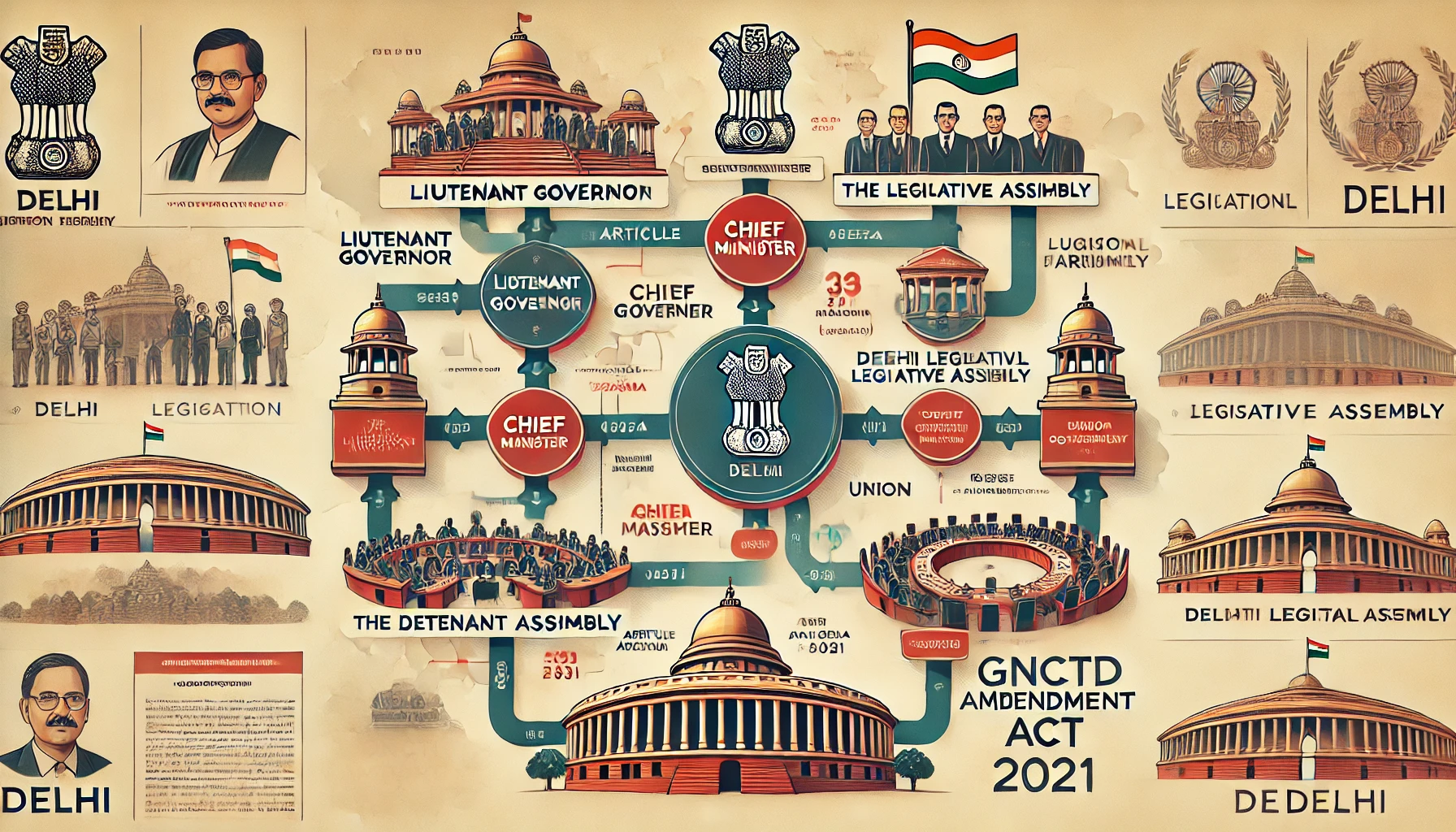RBI Governor’s Repo Rate Cut: Impact on Economy and Key Insights for Exams
Introduction
Delhi, the capital of India, holds a unique status in the constitutional framework of the country. Unlike other states, Delhi is a Union Territory (UT) with a special provision for governance under Article 239AA of the Constitution of India. The governance of Delhi involves both the Lieutenant Governor (LG) and the elected government, leading to a complex interplay of powers. This blog delves into the constitutional aspects of Delhi’s governance, focusing on the role of the LG and the challenges arising from its special status.
Constitutional Status of Delhi
Union Territory with a Legislative Assembly
Delhi is classified as a Union Territory under Article 239 of the Indian Constitution. However, through the 69th Constitutional Amendment Act, 1991, Article 239AA was inserted, granting Delhi a legislative assembly and a council of ministers. This amendment gave Delhi a special status, distinguishing it from other Union Territories.
Key provisions of Article 239AA:
- Legislative Assembly: Delhi has the power to make laws on subjects in the State List and Concurrent List, except for public order, police, and land.
- Council of Ministers: The Chief Minister (CM) and the council of ministers aid and advise the Lieutenant Governor.
- Lieutenant Governor: The LG is appointed by the President and acts as the administrator of Delhi.
Powers of the Delhi Legislative Assembly
The Delhi Legislative Assembly can make laws on various subjects except:
- Public Order
- Police
- Land These subjects remain under the direct control of the Union Government through the Lieutenant Governor.
Role of the Lieutenant Governor (LG)
Appointment and Authority
- The LG of Delhi is appointed by the President of India under Article 239.
- The LG functions as the representative of the Union Government and has powers similar to that of a Governor in a state but with significant discretionary authority.

Powers and Functions of the LG
- Executive Authority: The LG is the administrative head of Delhi and acts under the guidance of the President and the Union Home Ministry.
- Legislative Role: The LG gives assent to bills passed by the Delhi Legislative Assembly.
- Discretionary Powers: The LG can act independently in certain matters, especially those affecting public order, police, and land.
- Power to Refer Matters to the President: If there is a conflict between the Delhi government and the LG, the latter can escalate the matter to the President of India.
- Control Over Bureaucracy: The LG exercises authority over civil services and transfers/postings of bureaucrats in Delhi.
Conflict Between Delhi Government and the LG
The unique governance structure of Delhi has led to frequent disputes between the elected government and the LG. Some of the major issues include:
- Control Over Bureaucracy: The elected Delhi government has repeatedly contested the LG’s authority over civil servants and administrative matters.
- Legislative Powers: The Delhi Assembly’s limited power has led to conflicts, especially on issues related to governance and policymaking.
- Executive Decision-Making: The LG has discretionary powers that sometimes override the decisions of the elected government.
Landmark Supreme Court Judgments
1. Government of NCT of Delhi v. Union of India (2018)
- The Supreme Court ruled that the LG must act on the aid and advice of the Council of Ministers, except in matters reserved for the President.
- The judgment emphasized cooperative federalism and limited the discretionary powers of the LG.
2. GNCTD (Amendment) Act, 2021
- The Government of National Capital Territory of Delhi (Amendment) Act, 2021 clarified that “government” in Delhi means the Lieutenant Governor, reinforcing the LG’s authority over legislative and executive decisions.
Comparison with Other Union Territories
Delhi’s governance model is distinct from other UTs such as:
- Puducherry: Like Delhi, it has a legislative assembly, but the LG of Puducherry has lesser discretionary powers.
- Chandigarh, Lakshadweep, Andaman & Nicobar: These UTs are administered directly by the central government without an elected legislative assembly.
Previous Questions in Competitive Exams
Many competitive exams, including UPSC, State PSC, SSC, and judiciary exams, have asked questions related to Union Territories and the role of the LG. Some notable questions include:
- Which Article of the Indian Constitution grants special status to Delhi? (UPSC Prelims, 2019)
- (a) Article 239
- (b) Article 239AA
- (c) Article 243
- (d) Article 370
- Which of the following subjects is NOT under the Delhi Legislative Assembly’s jurisdiction? (SSC CGL, 2021)
- (a) Education
- (b) Police
- (c) Health
- (d) Transport
- Who appoints the Lieutenant Governor of Delhi? (State PSC, 2022)
- (a) Chief Minister of Delhi
- (b) President of India
- (c) Prime Minister of India
- (d) Union Home Minister
- Which Supreme Court case clarified the role of the LG in Delhi’s administration? (Judiciary Exam, 2023)
- (a) Kesavananda Bharati Case
- (b) Golaknath Case
- (c) Government of NCT of Delhi v. Union of India
- (d) Minerva Mills Case
- What is the significance of the Government of NCT of Delhi (Amendment) Act, 2021? (UPSC Mains, 2022)
- Short answer: The amendment reaffirmed the Lieutenant Governor as the head of the Delhi government, limiting the elected government’s powers.
- Under which Article does the President administer Union Territories?
- Which amendment introduced Article 239AA?
- Who has the final authority over the administrative decisions of Delhi?
- Which Union Territory in India has the most autonomy?
- What is the difference between a Governor and a Lieutenant Governor?
- Which constitutional body resolves disputes between the Delhi government and the LG?
- What role does the Union Home Ministry play in Delhi’s administration?
- Can Delhi’s status be changed to a full state through an amendment?
- Which committee recommended special status for Delhi?
- How does the governance structure of Delhi compare to other metropolitan cities like Mumbai and Kolkata?
Conclusion
Revolutionizing Temple Traditions: The Mechanical Elephant Kombara Kannan
The governance of Delhi remains a subject of constitutional debate and political contention. While the 2018 Supreme Court judgment reaffirmed the democratic principle that the elected government should have a say in administration, the 2021 Amendment Act re-established the dominant role of the LG. The evolving legal landscape suggests that Delhi’s governance structure may continue to be refined to balance federal principles and central authority.
In summary, Delhi is an exceptional case in India’s constitutional framework—neither a full-fledged state nor a typical Union Territory. The role of the Lieutenant Governor remains pivotal in maintaining a delicate balance between the elected government and the Union Government.



